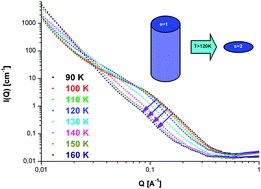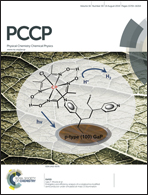Small-angle neutron scattering study of micropore collapse in amorphous solid water†
Abstract
Vapor-deposited amorphous solid water (ASW) is the most abundant solid molecular material in space, where it plays a direct role in both the formation of more complex chemical species and the aggregation of icy materials in the earliest stages of planet formation. Nevertheless, some of its low temperature physics such as the collapse of the micropore network upon heating are still far from being understood. Here we characterize the nature of the micropores and their collapse using neutron scattering of gram-quantities of D2O–ASW of internal surface areas up to 230 ± 10 m2 g−1 prepared at 77 K. The model-free interpretation of the small-angle scattering data suggests micropores, which remain stable up to 120–140 K and then experience a sudden collapse. The exact onset temperature to pore collapse depends on the type of flow conditions employed in the preparation of ASW and, thus, the specific surface area of the initial deposit, whereas the onset of crystallization to cubic ice is unaffected by the flow conditions. Analysis of the small-angle neutron scattering signal using the Guinier–Porod model suggests that a sudden transition from three-dimensional cylindrical pores with 15 Å radius of gyration to two-dimensional lamellae is the mechanism underlying the pore collapse. The rather high temperature of about 120–140 K of micropore collapse and the 3D-to-2D type of the transition unraveled in this study have implications for our understanding of the processing and evolution of ices in various astrophysical environments.


 Please wait while we load your content...
Please wait while we load your content...